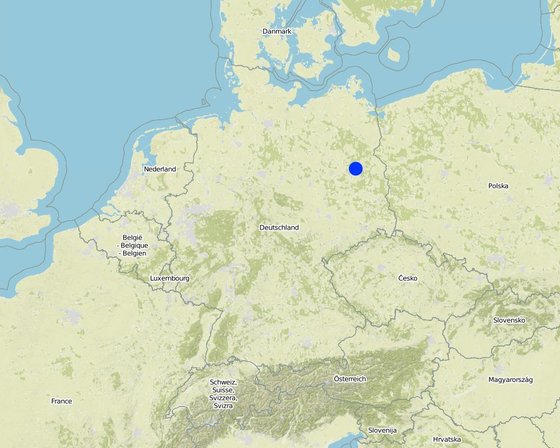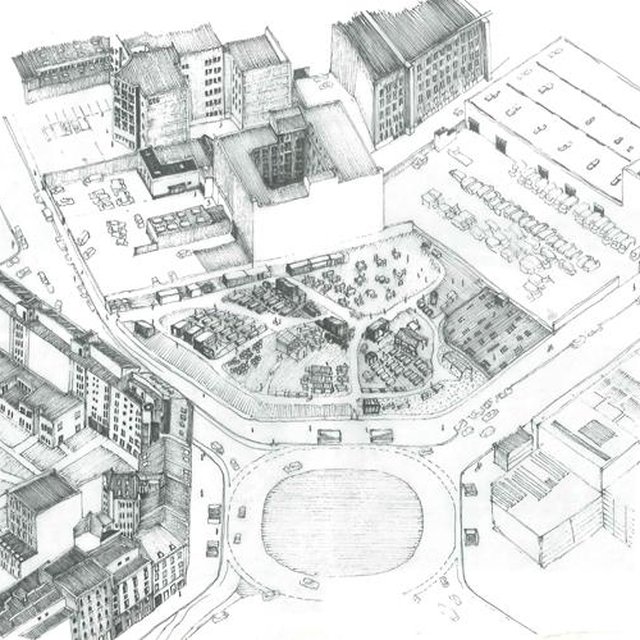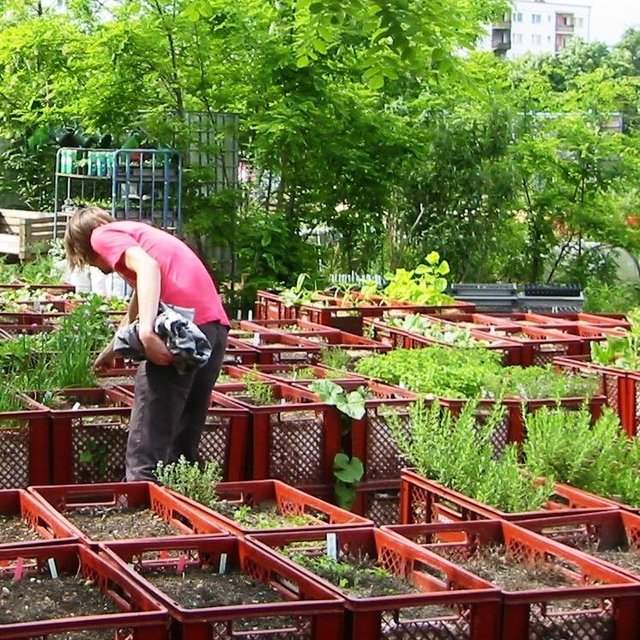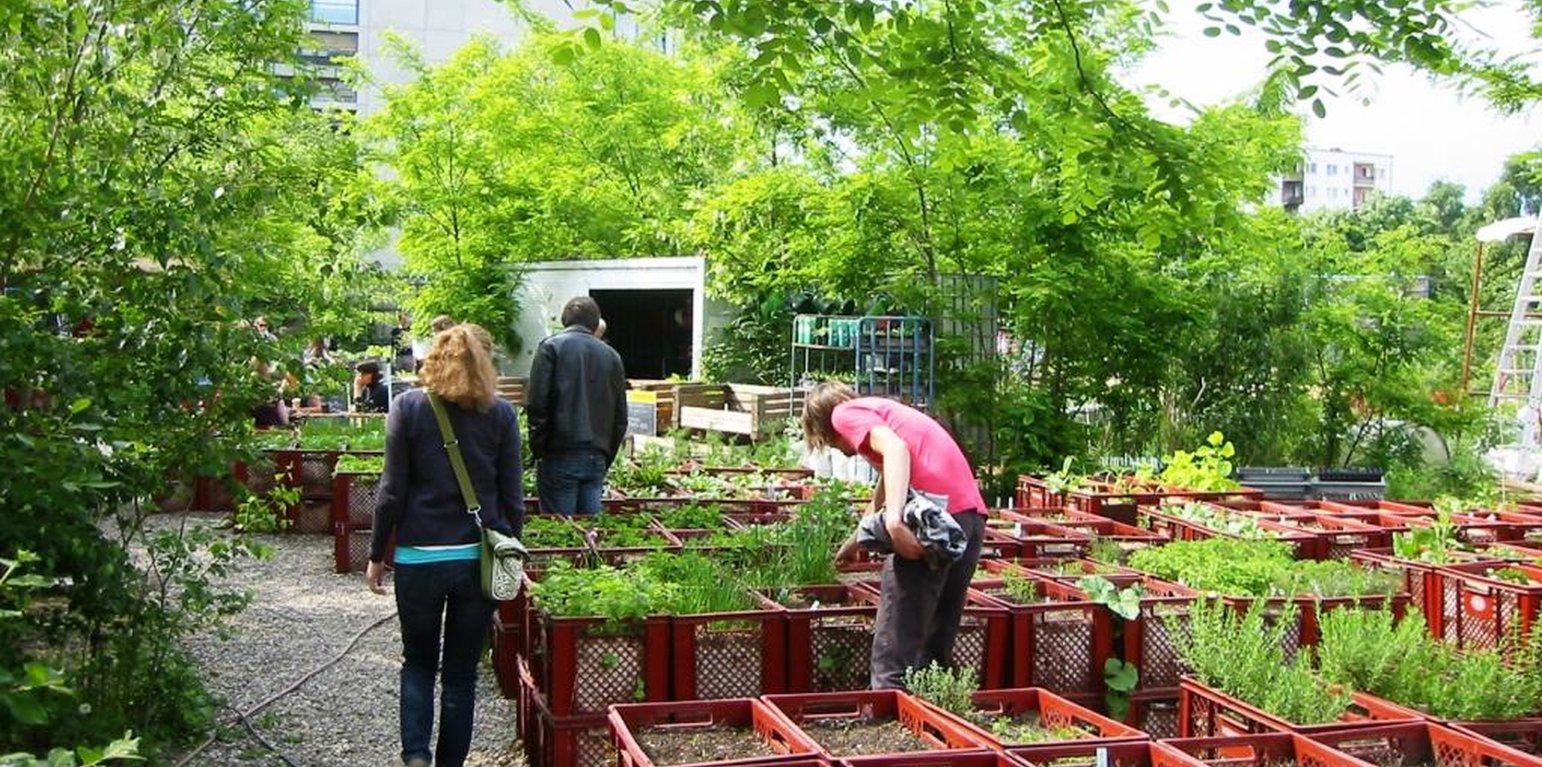Mobile Community Garden
(Germany)
Description
The SLM approach can be defined as community supported mobile urban farm, which serves the goals of vegetable production, and place of learning and knowledge sharing.
Aims / objectives: The objective of the SLM approach 'Prinzessinnengarten' was to create an urban garden on a waste land plot in the center of Berlin. The plot was characterised by having sealed and contaminated soils, which is characteristic for open land plots in most urban areas. The garden is supposed to practically demonstrate an ecologically and socially different approach to urban spaces and their inhabitants, enable the social empowerment of marginalized communities. Furthermore opportunities for local micro-economies and other economic models are supposed to be created. In an unobtrusive and pragmatic way, urban gardens in general aim to raise the question of 'How we want to live in our cities in the future?
Methods: The project was first was implemented by the group Nomadisch Grün (Nomadic Green) in summer of 2009. Along with friends, activists and neighbours, the group realised the first steps of implementation through clearing of rubbish and through the construction of the first cultivation units. The project, being open to everybody, attracted new participants quite fast. Now the garden owes its existence to the commitment of countless neighbors and interested people. The work of these participants, their diverse skills and ideas transform the place continuously.
Stages of implementation: I. Development of the idea. During this phase of implementation mainly Robert Shaw (he was involved in similar projects in Cuba before) and Marco Clausen were involved.. II. Implementation in practice. Starting in summer of 2009, the project idea was being implemented on the ground by a group of people. During this stage of implementation mainly physical work, such as the clearing of rubbish was realised. III. Opening to the wider public (still ongoing). The non-profit company 'Nomadisch Grün (Nomadic Green) serves as a framework for the different social, educational and economic activities with the primary aim of making the garden a place of learning. Skills are gained through practical experience and knowledge sharing.
Location

Location: Kreuzberg, Berlin, Germany
Geo-reference of selected sites
Initiation date: 2009
Year of termination: n.a.
Type of Approach
-
traditional/ indigenous
-
recent local initiative/ innovative
-
project/ programme based

(Natalia Hosie (http://prinzessinnengarten.net/de/was-passiert-im-))

Mobile cultivation beds (Assenmacher (under CC BY-SA, 3.0 License))
Approach aims and enabling environment
Main aims / objectives of the approach
The Approach focused mainly on other activities than SLM (utilisation of waste land/abandoned land plots, urban areas,production of vegetables, place of knowledge sharing)
The aim of the project was to find solutions for the lack of knowledge sharing within the society and to address the topic of food production.
The SLM Approach addressed the following problems: The main problems addressed by the approach can be described as manifold, e.g. insufficient local food production, or the general lack of public spaces for knowledge sharing and exchange within the community.
Conditions enabling the implementation of the Technology/ ies applied under the Approach
-
Legal framework (land tenure, land and water use rights): The existing land ownership, land use rights / water rights helped a little the approach implementation: As the existing land ownership was already known before the implementation of the approach started, this aspect was being strongly considered (leading to the design of a mobile cultivation system). Furthermore the existing land ownership (the community is owning the land) led to the possibility to have public negotiations about the renting contract. If the area would have been in private ownership such negotiations would not have been possible and it is more than likely that the Approach could not have been realised in the way it is realised now.
Conditions hindering the implementation of the Technology/ ies applied under the Approach
-
Availability/ access to financial resources and services: Treatment through the SLM Approach: attempt to diversify the income
-
Institutional setting: no official institution is clearly responsible for this type of approach
Treatment through the SLM Approach: regular exchange with politicians, especially on local level
-
Legal framework (land tenure, land and water use rights): no long term renting contract, no official institution is clearly responsible for this type of approach
Treatment through the SLM Approach: political campaign
-
Workload, availability of manpower: due to the high presence in the media there is a high demand for communication acitivities
Treatment through the SLM Approach: establishment of paid jobs to have people working professionally on certain topics
Participation and roles of stakeholders involved
Stakeholders involved in the Approach and their roles
| What stakeholders / implementing bodies were involved in the Approach? |
Specify stakeholders |
Describe roles of stakeholders |
| local land users/ local communities |
In the surroundings of the Moritzplatz a great part of the population were/are immigrants (most of them coming from muslim countries) and people without a job. In principle the project was/is open for all people, including disadvantaged groups as well. During the interviews it was said though that the selling and consumption of alcohol on the project area could have led to the fact that especially immigrants from muslim countries could have been felt excluded. |
|
Involvement of local land users/ local communities in the different phases of the Approach
none
passive
external support
interactive
self-mobilization
initiation/ motivation
There was a constant change of the people that were being involved in the different phases of the project. The decision to what degree people got involved, were to be taken under the consideration of the personal needs and possibilities.
planning
There was a constant change of the people that were being involved in the different phases of the project. The decision to what degree people got involved, were to be taken under the consideration of the personal needs and possibilities.
implementation
There was a constant change of the people that were being involved in the different phases of the project. The decision to what degree people got involved, were to be taken under the consideration of the personal needs and possibilities.
monitoring/ evaluation
There was a constant change of the people that were being involved in the different phases of the project. The decision to what degree people got involved, were to be taken under the consideration of the personal needs and possibilities.
Decision-making on the selection of SLM Technology
Decisions were taken by
-
land users alone (self-initiative)
-
mainly land users, supported by SLM specialists
-
all relevant actors, as part of a participatory approach
-
mainly SLM specialists, following consultation with land users
-
SLM specialists alone
-
politicians/ leaders
Decisions were made based on
-
evaluation of well-documented SLM knowledge (evidence-based decision-making)
-
research findings
-
personal experience and opinions (undocumented)
Technical support, capacity building, and knowledge management
The following activities or services have been part of the approach
-
Capacity building/ training
-
Advisory service
-
Institution strengthening (organizational development)
-
Monitoring and evaluation
-
Research
Capacity building/ training
Training was provided to the following stakeholders
-
land users
-
field staff/ advisers
Form of training
-
on-the-job
-
farmer-to-farmer
-
demonstration areas
-
public meetings
-
courses
Subjects covered
Through creating a open public space/place and by offering manifold practical activity the approach provides training by using a peer to peer approach on topics like biodiversity, healthy eating, recycling, environmental justice, climate change and food sovereignty. This training / awareness raising takes place informally (peer to peer) as well as formally (announced courses, lectures, discussions)
Advisory service
Advisory service was provided
-
on land users' fields
-
at permanent centres
Advisory service is inadequate to ensure the continuation of land conservation activities
Monitoring and evaluation
bio-physical aspects were ad hoc monitored by land users through observations
bio-physical aspects were regular monitored by other through measurements
technical aspects were ad hoc monitored by land users through observations
socio-cultural aspects were ad hoc monitored by land users through observations
economic / production aspects were ad hoc monitored by land users through observations
no. of land users involved aspects were ad hoc monitored by land users through observations
management of Approach aspects were ad hoc monitored by land users through observations
There were several changes in the Approach as a result of monitoring and evaluation: There is a constant change according to the findings of the monitoring and the needs/possibilites of the project participants.
There were few changes in the Technology as a result of monitoring and evaluation: The research of the Technical University of Berlin showed that vegetables which were cultivated very close to the street, contained more pollutants. Therefore a 'green belt' of about 2 m width was established around the garden, where only non-food-crops are cultivated
Research
Research treated the following topics
-
sociology
-
economics / marketing
-
ecology
-
technology
There was research on the soil and plant quality and possible contamination of the soil and the plants (performed e.g. by the Technical University of Berlin)
Research was carried out both on station and on-farm
Financing and external material support
Annual budget in USD for the SLM component
-
< 2,000
-
2,000-10,000
-
10,000-100,000
-
100,000-1,000,000
-
> 1,000,000
Precise annual budget: n.a.
Approach costs were met by the following donors: local community / land user(s): 100.0%
The following services or incentives have been provided to land users
-
Financial/ material support provided to land users
-
Subsidies for specific inputs
-
Credit
-
Other incentives or instruments
Financial/ material support provided to land users
partly financed
fully financed
Kitchen
For educational purposes
Labour by land users was
-
voluntary
-
food-for-work
-
paid in cash
-
rewarded with other material support
Impact analysis and concluding statements
Impacts of the Approach
No
Yes, little
Yes, moderately
Yes, greatly
Did the Approach help land users to implement and maintain SLM Technologies?
The approach helped the land users to cultivate on areas, which were not suitable for cultivation before. Furthermore the approach enhanced the knowledge sharing concering different topics regarding sustainable land management. Therefore the impact of the Approach on SLM is not only to be measured on the project area itself, but also under consideration of the outreach of the project.
Did the Approach empower socially and economically disadvantaged groups?
Through the Approach a space for knowledge sharing was created, which is also open for socially and economically disadvantaged groups. The utilisation of this space by the groups in question is limited up to date though.
Did other land users / projects adopt the Approach?
The approach was adopted in modified ways in several urban gardening projects accross Germany. It is not possible to quantify the number. A guess would be around 20.
Main motivation of land users to implement SLM
-
increased production
-
increased profit(ability), improved cost-benefit-ratio
-
reduced land degradation
-
reduced risk of disasters
-
reduced workload
-
payments/ subsidies
-
rules and regulations (fines)/ enforcement
-
prestige, social pressure/ social cohesion
-
affiliation to movement/ project/ group/ networks
-
environmental consciousness
-
customs and beliefs, morals
-
enhanced SLM knowledge and skills
-
aesthetic improvement
-
conflict mitigation
-
well-being and livelihoods improvement
Sustainability of Approach activities
Can the land users sustain what hat been implemented through the Approach (without external support)?
Through the diverse income opportunities (consulting, selling/using the produce in gastronomy, donation) the Approach activities can be self-financed.
Conclusions and lessons learnt
Strengths: land user's view
-
not dependent on a certain plot (mobility, flexibility)
-
flat hierachy leads to the fact, that a lot of people can bring in their ideas easily
-
Everybody can decide on his/her own to what extend he/she wants to get involved and in what kind of activity. Through this the participants can focus on their strengths and there is little chance that overworking occurs.
-
Creation of paid jobs
Strengths: compiler’s or other key resource person’s view
-
self-financed
-
sharing of knowledge (possible between all participants)
-
open to everybody
Weaknesses/ disadvantages/ risks: land user's viewhow to overcome
-
only to a certain point 'sustainable', as the project is dependent on a great amount of external inputs (water, plastic boxes)
Weaknesses/ disadvantages/ risks: compiler’s or other key resource person’s viewhow to overcome
-
only to a certain point 'sustainable', as the project is dependent on a great amount of external inputs (water, plastic boxes)
References
Date of documentation: June 30, 2015
Last update: July 24, 2017
Resource persons
-
Peter Kirch (peter.kirch@alumni.hu-berlin.de) - SLM specialist
-
Robert Shaw (kontakt@prinzessinnengarten.net) - SLM specialist
Full description in the WOCAT database
Documentation was faciliated by
Institution
- Technische Universität Berlin (Technische Universität Berlin) - Germany
Project
Key references
-
website, 2015: prinzessinnengarten.net/






